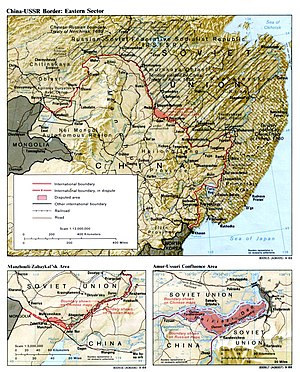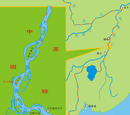Sino-Soviet border conflict
| Sino-Soviet border conflict | |||||||||
|---|---|---|---|---|---|---|---|---|---|
| Part of the Cold War and the Sino-Soviet split | |||||||||
 Some of the disputed areas in the Argun and Amur rivers. Damansky/Zhenbao is to the southeast, north of the lake |
|||||||||
|
|||||||||
| Belligerents | |||||||||
|
|
|
||||||||
| Commanders and leaders | |||||||||
|
|
|
||||||||
| Strength | |||||||||
| 658,000 | 814,000 | ||||||||
| Casualties and losses | |||||||||
| 59 killed 94 wounded (Soviet sources) 27 Tanks/APCs destroyed (Chinese sources) 1 Command Car (Chinese sources) Dozens of trucks destroyed (Chinese sources) One Soviet T-62 tank captured |
71 killed and 68 wounded (Chinese sources) ~800 killed (Soviet sources) |
||||||||
| Sino-Soviet border conflict | |||||||||||||

Zhenbao Island and the border.
|
|||||||||||||
| Chinese name | |||||||||||||
|---|---|---|---|---|---|---|---|---|---|---|---|---|---|
| Traditional Chinese | 中蘇邊界衝突 | ||||||||||||
| Simplified Chinese | 中苏边界冲突 | ||||||||||||
|
|||||||||||||
| Alternative Chinese name | |||||||||||||
| Traditional Chinese | 珍寶島自衛反擊戰 | ||||||||||||
| Simplified Chinese | 珍宝岛自卫反击战 | ||||||||||||
| Literal meaning | Zhenbao Island self-defense | ||||||||||||
|
|||||||||||||
| Russian name | |||||||||||||
| Russian | Пограничный конфликт на острове Даманский | ||||||||||||
| Romanization | Pograničnyj konflikt na ostrove Damanskij | ||||||||||||
| Transcriptions | |
|---|---|
| Standard Mandarin | |
| Hanyu Pinyin | Zhōng Sū biānjiè chōngtū |
| IPA | [ʈʂʊ́ŋ sú pjɛ́ntɕjê ʈʂʰʊ́ŋtʰú] |
| Yue: Cantonese | |
| Jyutping | Zung1 Sou1 bin1gaai3 cung1dat6 |
| Transcriptions | |
|---|---|
| Standard Mandarin | |
| Hanyu Pinyin | Zhēnbǎo dǎo zìwèi fǎnjí zhàn |
The Sino-Soviet border conflict was a seven-month undeclared military conflict between the Soviet Union and China at the height of the Sino-Soviet split in 1969. Although military clashes ceased that year, the underlying issues were not resolved until the 1991 Sino-Soviet Border Agreement.
The most serious of these border clashes—which brought the two communist-led countries to the brink of war—occurred in March 1969 in the vicinity of Zhenbao (Damansky) Island on the Ussuri (Wusuli) River; as such, Chinese historians most commonly refer to the conflict as the Zhenbao Island Incident.
Under the governorship of Sheng Shicai (1933–1944) in northwest China's Xinjiang (then Sinkiang) province, China's nationalist Kuomintang recognized for the first time the existence of a "Uyghur people", following Soviet ethnic policy. This ethnogenesis of a "national" people eligible for territorialized autonomy broadly benefited the Soviet Union, which organized conferences in Fergana and Semirechye (in Soviet Central Asia), in order to cause "revolution" in Altishahr (southern Xinjiang) and Dzungaria (northern Xinjiang). Both the Soviet Union and the White movement covertly armed and fought with the Ili National Army which fought against the Kuomintang in the Three Districts Revolution. Although the mostly Muslim Uyghur rebels participated in pogroms against Han Chinese in general, the turmoil eventually just resulted in the replacement of Kuomintang rule in Xinjiang (northwest China) with that of the Communist Party of China in the 1940s.
...
Wikipedia
